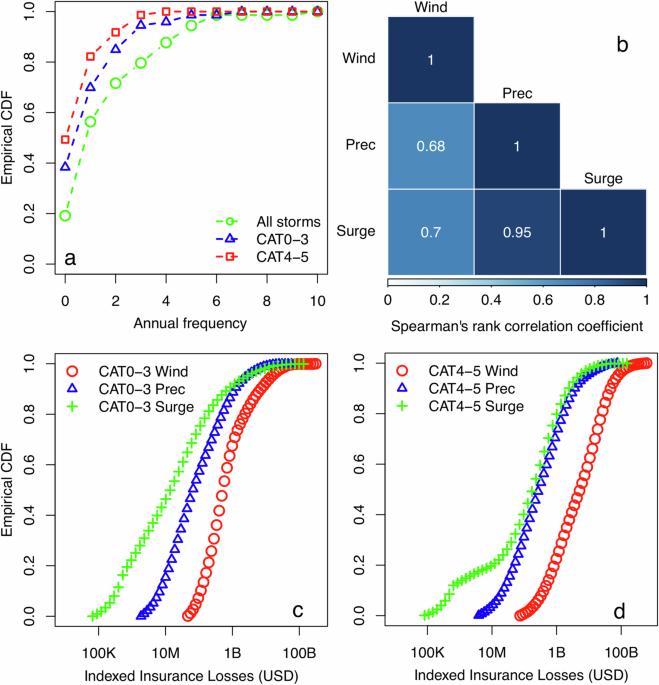Increase in insurance losses caused by North Atlantic hurricanes in a warmer climate
IF 8.1
1区 地球科学
Q1 ENVIRONMENTAL SCIENCES
引用次数: 0
Abstract
North Atlantic hurricanes are a major driver of property losses in the United States and a critical peril for the reinsurance industry globally. We leverage insurance loss data and stochastic modeling to investigate the impacts of projected changes in hurricane climatology on the insurance industry, for +2 °C and +4 °C warming scenarios. We find that, relative to the historical baseline 1950-2022, expected changes in wind speed and rainfall may increase hurricane losses by 5% −15% (+2 °C) and 10% − 30% (+4 °C), with greater impacts at lower return periods than in the tail. The historical 100-year loss event may therefore be exceeded on average every 80 years (+2 °C) and 70 years (+4 °C). The expected changes in average annual loss are projected to be 10% (+2 °C) and 15% (+4 °C), with the largest relative increase attributable to precipitation-induced losses. Under the extreme SSP5-8.5 scenario, the expected loss inflation due to climate change is thus on the order of 0.5% per annum. Expected changes in wind speed and rainfall associated with North Atlantic hurricanes could increase property insurance losses by 10% for a scenario of 2 degrees of warming, with greater impacts on the more frequent events, suggests an analysis of historical data with stochastic modelling.

气候变暖导致北大西洋飓风造成的保险损失增加
北大西洋飓风是美国财产损失的主要驱动因素,也是全球再保险业的重要危险。我们利用保险损失数据和随机建模,研究了+2 °C和+4 °C升温情景下飓风气候学预测变化对保险业的影响。我们发现,相对于 1950-2022 年的历史基线,风速和降雨量的预期变化可能会使飓风损失增加 5% -15%(+2 °C)和 10% - 30%(+4 °C),在较低的重现期比尾部影响更大。因此,平均每 80 年(+2 °C)和 70 年(+4 °C)就可能超过历史上的 100 年损失事件。预计平均年损失变化为 10%(+2 °C)和 15%(+4 °C),最大的相对增加可归因于降水引起的损失。因此,在极端 SSP5-8.5 情景下,气候变化导致的预期损失膨胀每年约为 0.5%。对历史数据的随机建模分析表明,与北大西洋飓风相关的风速和降雨量的预期变化会使财产保险损失在升温 2 度的情况下增加 10%,对更频繁的事件影响更大。
本文章由计算机程序翻译,如有差异,请以英文原文为准。
求助全文
约1分钟内获得全文
求助全文
来源期刊

Communications Earth & Environment
Earth and Planetary Sciences-General Earth and Planetary Sciences
CiteScore
8.60
自引率
2.50%
发文量
269
审稿时长
26 weeks
期刊介绍:
Communications Earth & Environment is an open access journal from Nature Portfolio publishing high-quality research, reviews and commentary in all areas of the Earth, environmental and planetary sciences. Research papers published by the journal represent significant advances that bring new insight to a specialized area in Earth science, planetary science or environmental science.
Communications Earth & Environment has a 2-year impact factor of 7.9 (2022 Journal Citation Reports®). Articles published in the journal in 2022 were downloaded 1,412,858 times. Median time from submission to the first editorial decision is 8 days.
 求助内容:
求助内容: 应助结果提醒方式:
应助结果提醒方式:


